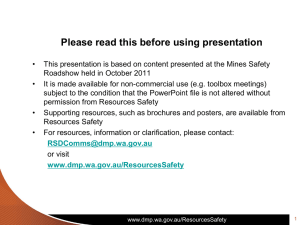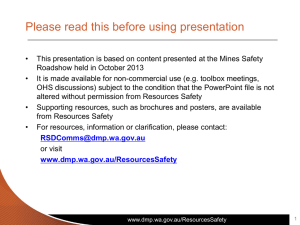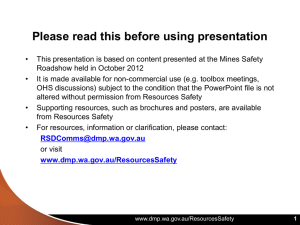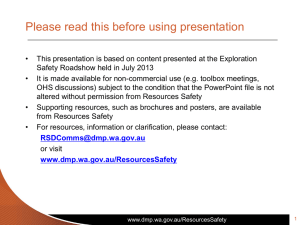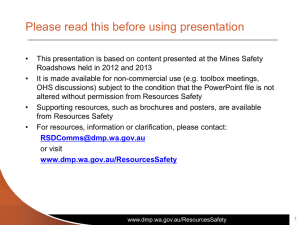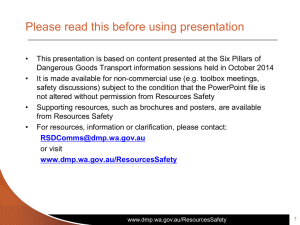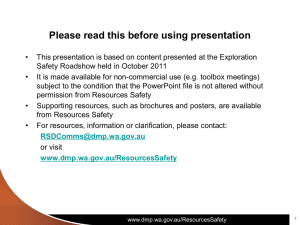Improving hazard awareness
advertisement
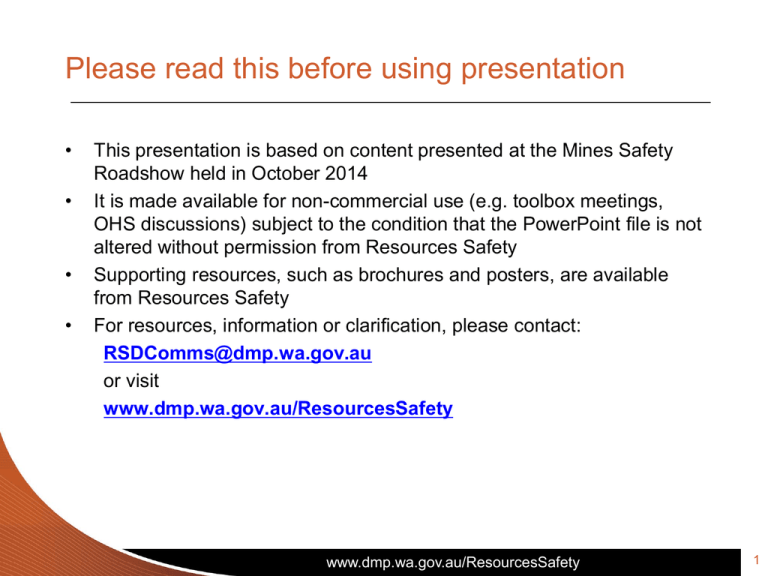
Please read this before using presentation • • • • This presentation is based on content presented at the Mines Safety Roadshow held in October 2014 It is made available for non-commercial use (e.g. toolbox meetings, OHS discussions) subject to the condition that the PowerPoint file is not altered without permission from Resources Safety Supporting resources, such as brochures and posters, are available from Resources Safety For resources, information or clarification, please contact: RSDComms@dmp.wa.gov.au or visit www.dmp.wa.gov.au/ResourcesSafety www.dmp.wa.gov.au/ResourcesSafety 1 Improving hazard awareness Lifting the game – resources to raise awareness of lifting and rigging issues www.dmp.wa.gov.au/ResourcesSafety 2 Resources Safety’s focus on mines safety • Maintenance and service activities • Hazardous manual tasks • Fit for purpose • Principal hazard management plans • Safety in design • Assessment of competence • Traffic management • Job risk assessment tools (e.g. JHAs, JSAs) • Fitness for work • Management and supervision • Safety and health representatives www.dmp.wa.gov.au/ResourcesSafety 3 What are we looking at today? • Stored energy • Gravitational potential energy • Issues relating to mechanical handling – centre of gravity – friction – tensile strength and metallurgy www.dmp.wa.gov.au/ResourcesSafety 4 Stored energy • Force (N) • Energy (J) 1 Nm www.dmp.wa.gov.au/ResourcesSafety 5 Sir Isaac Newton • Lived 1642-1727 • British physicist & mathematician • SI Unit of force = Newton (N) www.dmp.wa.gov.au/ResourcesSafety 6 James Prescott Joule • Lived 1818-1889 • British physicist • SI Unit of energy = Joule (J) www.dmp.wa.gov.au/ResourcesSafety 7 Stored energy 1 Joule (J) = 1 Newton metre www.dmp.wa.gov.au/ResourcesSafety 8 Example of stored energy Gravitational potential energy = m x g x h m = mass (kg) g = gravity (m/s2) 9.81 h = height (m) Example: 6 x 9.81 x 5 = 294.3 www.dmp.wa.gov.au/ResourcesSafety J 9 Human-generated stored energy Deadlift (world record) m x g x h = ? x 9.81 x 0.8 = ? J www.dmp.wa.gov.au/ResourcesSafety 10 Human-generated stored energy Deadlift (world record) m x g x h = 523 x 9.81 x 0.8 = 4,104 J Z. Savickas [REF 1] www.dmp.wa.gov.au/ResourcesSafety 11 Human-generated stored energy What would be typical? Manual handling of 25 kg m x g x h = 25 x 9.81 x 0.8 = 196 J www.dmp.wa.gov.au/ResourcesSafety 12 Lethality criteria for debris generated from accidental explosions (2010) Probability of fatality 1.0 0.8 0.6 0.4 0.2 0 10 100 200 300 Kinetic energy (Joules) www.dmp.wa.gov.au/ResourcesSafety 1,000 [REF 2] 13 What does this all mean? Say ~300 J ≈ 98% chance of a fatality Looking at gravitational potential energy for cranes and objects at height m x g x h > 300 J www.dmp.wa.gov.au/ResourcesSafety 14 Energy (m x g x h) to equal 300 J 100.0 90.0 80.0 Height (m) 70.0 60.0 >300 J 50.0 40.0 30.0 20.0 10.0 <300 J 0.0 0 1 2 3 4 5 6 7 8 9 10 Mass (kg) www.dmp.wa.gov.au/ResourcesSafety 15 Issues with mechanical handling • Human limit ~ 500 kg (½ tonne), limited application • Most humans ~ 50 kg maximum • Need for mechanical lifting on mining operations Largest crane (bridge) in last few years = 122 t + 75 t = 197 t @ 38 m m x g x h = 197,000 x 9.81 x 38 = 73,437,766 J 73 MJ www.dmp.wa.gov.au/ResourcesSafety 16 Why are we covering these issues? • The number of fatalities, accidents and injuries – and near misses • Of the 60 fatalities in WA since 2000, five involved mechanical handling www.dmp.wa.gov.au/ResourcesSafety 17 ConocoPhillips Marine study Extrapolating ~15 years of data 5 150 1,500 15,000 1,500,000 [REF 3] www.dmp.wa.gov.au/ResourcesSafety 18 What are some requirements? • High Risk Work Licences [r. 6.37, MSIR 1995] Note: CN ≠ DG, RB, RI, RA • Verification of competency (VOC) on mine site [r. 4.13, MSIR 1995] • Still many accidents, injuries and potentially serious occurrences www.dmp.wa.gov.au/ResourcesSafety 19 Some topics to raise awareness • Centre of gravity (invisible) • Friction (can be invisible) • Tensile strength and metallurgy (can be invisible) www.dmp.wa.gov.au/ResourcesSafety 20 Centre of gravity – video 1 www.dmp.wa.gov.au/ResourcesSafety 21 Centre of gravity – key messages • The centre of gravity is not always obvious • Determine the location of your load’s centre of gravity before lifting • Be aware of moving loads ‒ including liquids www.dmp.wa.gov.au/ResourcesSafety 22 Friction – video 2 www.dmp.wa.gov.au/ResourcesSafety 23 Friction – key messages • Friction can be variable, and is usually given as a range For example: Steel–steel from 0.8 to 0.1 (factor of 8!) Steel–nylon from 0.25 to 0.3 [REF 4] • Options – Eliminate reliance on friction – Increase friction www.dmp.wa.gov.au/ResourcesSafety 24 Tensile strength – video 3 www.dmp.wa.gov.au/ResourcesSafety 25 Tensile testing - metallurgy Overloaded once Overloaded twice Overloaded again www.dmp.wa.gov.au/ResourcesSafety 26 Metallurgy exercise Whole wire – bend back and forth through the middle Nicked wire – bend on the nick How many times did you bend the whole wire before it broke? What about the nicked wire? www.dmp.wa.gov.au/ResourcesSafety 27 Tensile strength & metallurgy – key messages • Do not exceed load ratings (WLL) ‒ otherwise “bomb is ticking” • Condition of lifting equipment is important ‒ check for deformation and damage www.dmp.wa.gov.au/ResourcesSafety 28 Ask yourself … • Can I identify hazards associated with stored energies in mechanical handling? • Where is the centre of gravity of my load? Can it move? • Am I relying on friction to hold my load? Can I eliminate this need? • Is the lifting equipment in good order and hasn’t been overloaded? – any deformation? (e.g. elongation) – any damage? (e.g. nicks, notches, kinks) www.dmp.wa.gov.au/ResourcesSafety 29 Take-away message The human body is very fragile. Where mechanical handling is involved it almost invariably entails energies that exceed human tolerability. www.dmp.wa.gov.au/ResourcesSafety 30 References (for those interested!) 1. Deadlift world record www.youtube.com/watch?v=SBFTB7Xjk3U <viewed 11 August 2014> 2. Lethality Criteria for Debris Generated from Accidental Explosions (2010) Author : Mr Jon Henderson, Deputy Chief Inspector Explosives (MoD) Fir 3 C, #4304, MOD Abbeywood, Bristol, BS32 8JH 3. Conoco Phillips Safety Triangle www.osha.gov/dte/grant_materials/fy11/sh-2231811/Mod_3_ParticipantManual.pdf <viewed 8 October 2014> 4. Poly-Tech Industrial - Products www.polytechindustrial.com/products/plastic-stock-shapes/nylon-66 <viewed 8 October 2014> www.dmp.wa.gov.au/ResourcesSafety 31
